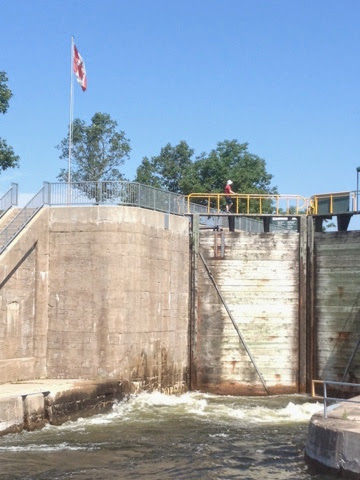A brief history on how we ran ITHAKA from the upper reaches of the beautiful Hudson River Vallley in upper New York State to the Canadian waters of Georgian Bay on Lake Huron. In one word, the answer is LOCKS!
Starting in Waterford, NY and heading west after passing through the only federal lock at Troy, NY, we traveled half the length of the Erie Canal, (this is the same Erie Canal that had its southern terminus in our hometown of Evansville, IN). After 4 travel days (days that we moved the boat), 22 locks and 162 miles
on the Erie Canal, we passed through Lock 23 of the Erie Canal and the 7 locks of the Oswego Canal on our fifth travel day. This brought us to the southern shore of Lake Ontario. After crossing Lake Ontario directly from Oswego, NY to Trenton, Ontario, Canada, a distance of 86 miles, we entered into the famous Trent-Severn Waterway (TSW).
The TSW is a waterway that is made up of a number of canals and locks connecting numerous lakes and rivers. During the seven travel days it took us to navigate the 43 locks on the TSW we traveled a distance of 241 miles. In total travel days, miles covered and locks transited to go from Waterford, NY to Port Severn, Ontario, Canada, we traveled 13 days, covered 525 miles and transited 73 locks. The following are photos of some of the various locks and
villages along the TSW.
Coming under the first bridge in Trenton, Ontario, the Gateway to the Trent-Severn Waterway.
The channel leading to the first lock.
Approaching the first lock and adjacent dam.
At top of one of the locks, the V shaped device with handles on it is how the gates of the lock are manually opened and closed. See following picture.
The men and women who serve as lock masters must turn this V manually by walking around in circles as it opens and closes the gates to the lock.
Canadian sign telling what lock on the TSW you are transiting.
Approaching the next lock gate with the trawler Terry-Ann in front.
Lock gates are closed as we approach the lock.
This lock is closed but is releasing the water inside the lock in preparation for opening.
Note the turbulent water at the base of the gates prior to opening.
Finally the gates open and the little pleasure boat exits and allows us to enter.
Inside the first set of Flight Locks at Ranney Falls. A flight lock is a double set of locks. As you exit the first lock, you immediately enter the second lock. Flight locks are built when a large lift must be achieved in a short distance. In this case 48' of vertical lift in the combined locks.
The pleasure boat that locked thru Ranney Falls with us. This was their new and first boat and their first lock ever. They were a little anxious to say the least.
Sara waiting on the bow for the lifting to start.
Approaching lock 21, the Peterborough Lift Lock. Completed in 1904, this is the highest hydraulic lift lock in the world and was an engineering marvel at the time. It has operated continuously for 110 years with no major changes to its functioning or engineering.
Each of the two pans weighs 1300 tons when filled with water. With one pan up and the other down, the two balance each other. It does not matter how many boats are in either pan. A boat displaces it's own weight in water. When it is time to lower one pan and raise the other, one extra foot of water (130 tons) is allowed to enter the upper pan. This extra weight allows the upper pan to push down and raise the lower pan to the top level. The two pans are locked in place and the extra water is let out of the lower pan. Boats enter and exit the upper and lower pans and the process is repeated.
The Pan on the right is in the up position.
Looking out over the edge of the pan that is in the up position, getting ready to descend.

After a long day and many locks, a nice calm, peaceful evening tied to a wall. It is light until 2115, or 9:30 PM for you civilians. :-)

At lock 27, Young's Point, we decided to stop after going through the lock so Sara could do a little shopping at the Lockside Trading Company. A little general store that had just about one of everything. Sara crossing over the lock gates on her way to the store.
The Lockside Trading Company.
One of Sara's favorite signs.
Our pretty floating home at lock 27.
Not all Canadians have their own boat on the TSW. Some have their own float plane sitting at their dock.
One of the scarier places on the TSW is called the "Narrows" of the Trent Canal, for obvious reasons. It is a three mile section cut through the Canadian Shield,
a geological feature of solid granite that covers half of Canada. It is extremely shallow and extremely narrow, sometimes no more than 20' wide with less than 4' of water under the keel.
The sharp granite rocks just under the surface as we transit the "Narrows".
Another picture of the "Narrows" that was a little more narrow than the one above!
Hole in the Wall Bridge built in 1905 at mile 173 of the TSW.
Playing Follow the Leader as we approach yet another lock on the TSW.






























































